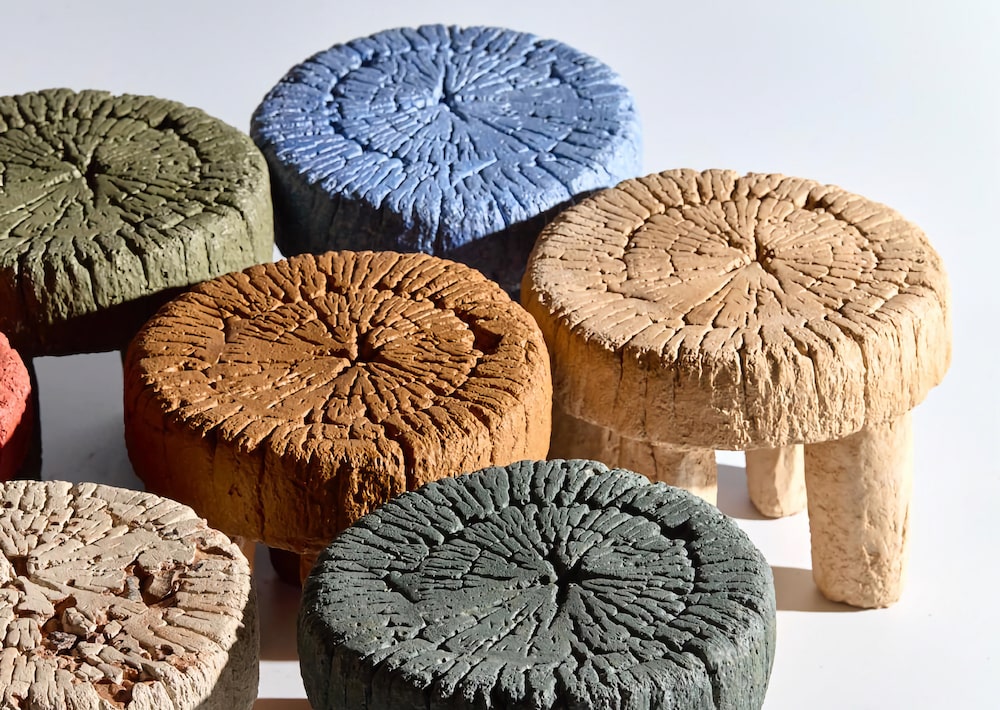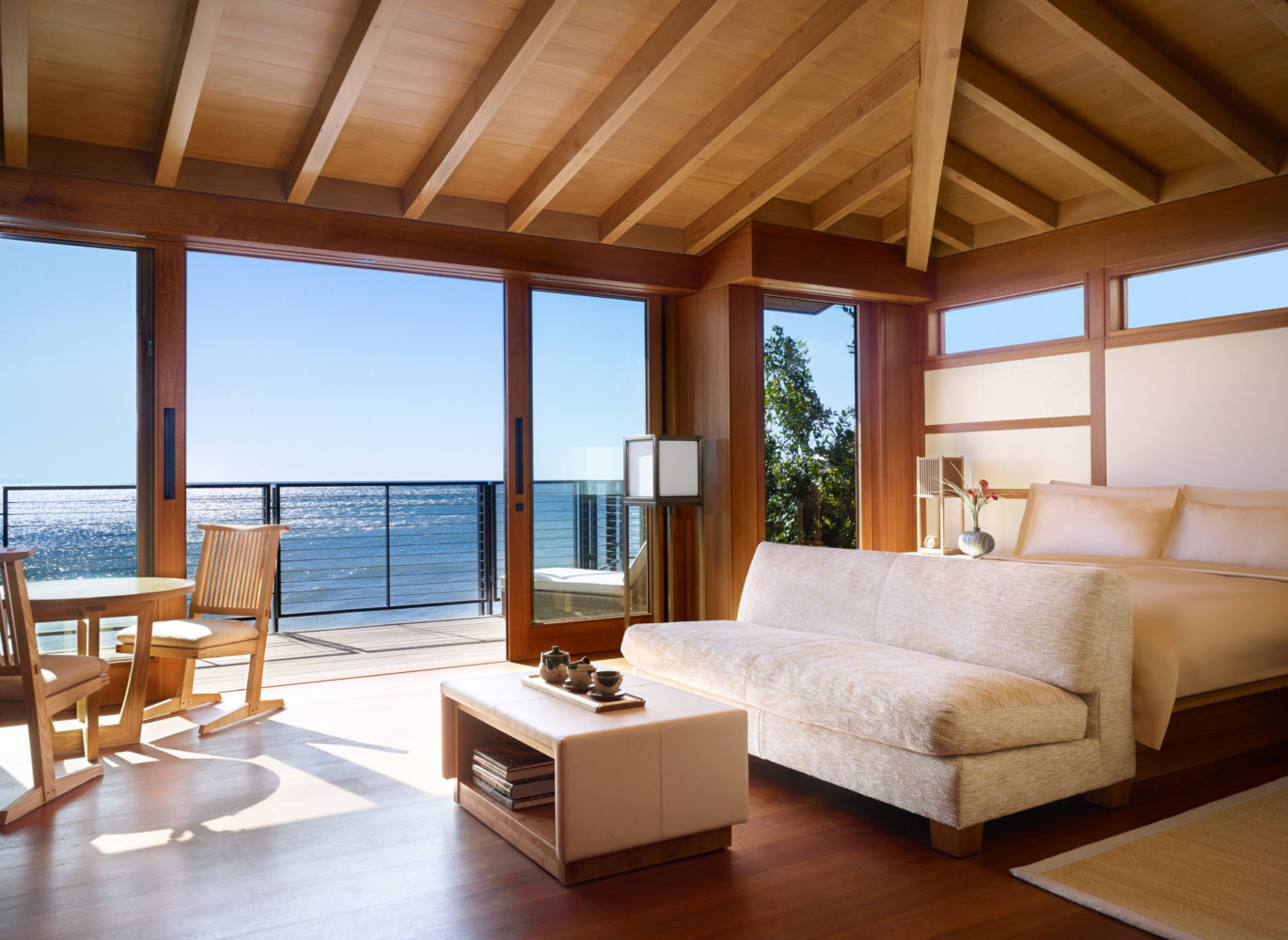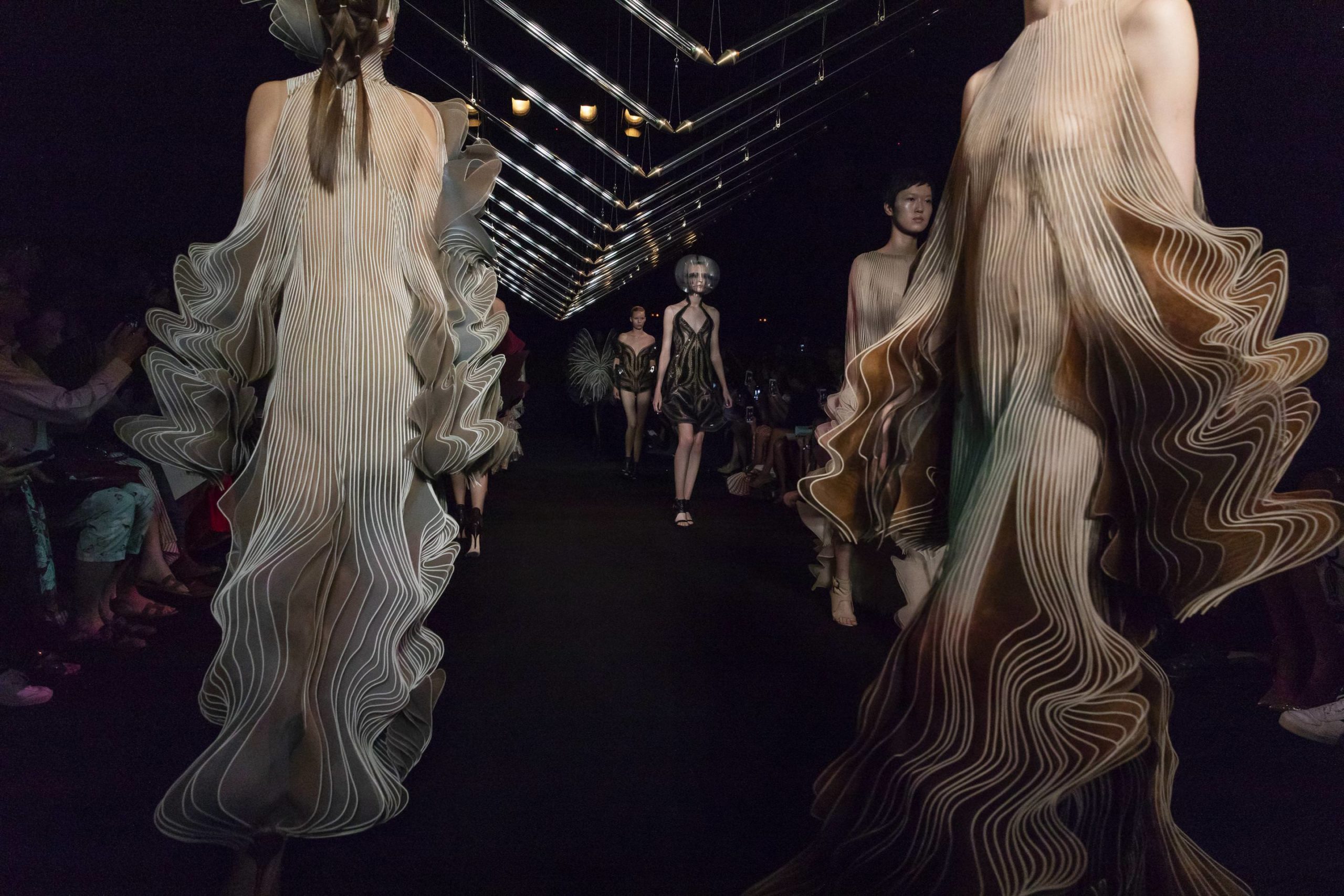The Toronto-based architecture studio PARTISANS recently completed Fold House—a two-story home in the hillside of Southern Ontario that keeps unending attention with swells of smooth wood held by a sturdy steel structure. Nestled into the hill, the lower level features a pool pavilion with an 80-feet-long sliding glass façade at its side. Burrowed, the space features a sweeping view from the low vantage point, revealing a heritage site that is hidden behind a stone wall and 200-year-old maple and oak trees, with a connecting guest home.
Established in 2012 by Alex Josephson and Pooya Baktash, and later joined by Jonathan Friedman, PARTISANS is transforming the vision of its industry through experimental design, technology, and complex projects.
For almost a decade, PARTISANS has been behind small- and large-scale residential, retail, hospitality, and gathering spaces with sophisticated details that greet guests with warmth. Its calming Grotto Sauna is an example of the studio’s relationship with material and surrounding, with design inspired by the rippling waves just feet away. The sauna rests on the land of a private property in Georgian Bay, Ontario, with a wavy all-reclaimed cedar wood interior sculpted by old-world craftsmanship, cutting-edge software, and fabrication technology.
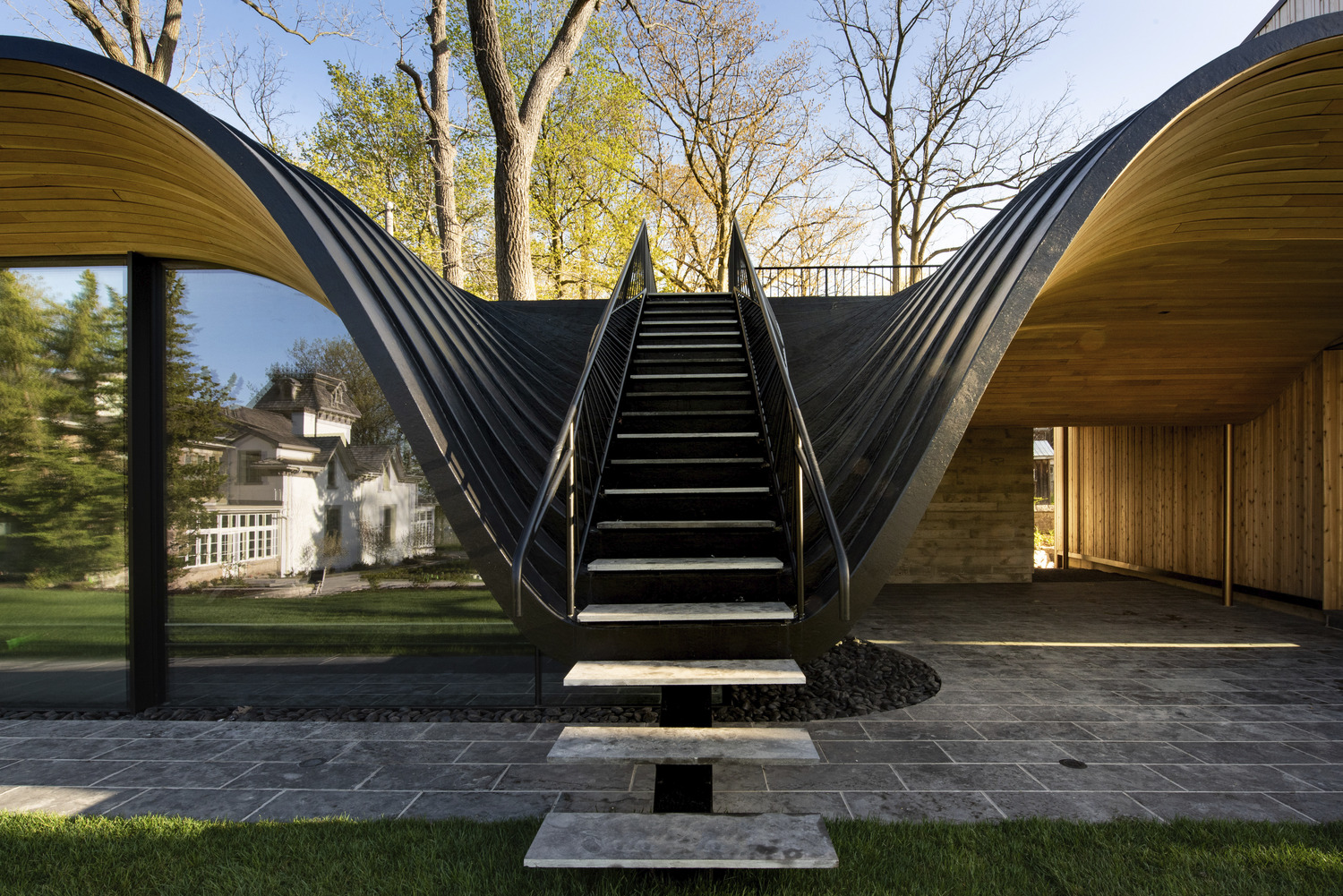
Fold House, courtesy of PARTISANS.
In contrast, their lively four-floor, 280-seat restaurant Gusto 501 in Toronto breaks away from traditional stacked spaces. Previously a car garage, the restaurant now features PARTISANS touches that invite the eye to explore unassuming details, like a massive glass façade and roof, walls made of terracotta and steel, and brickwork that was complexly cut to include integrated back-lit LED lights within the blocks.
Whitewall spoke with the firm’s founders to learn more about the evolution of PARTISANS, how it’s redesigning the downtown Toronto scene with The Orbit, and the changes they’re going through amid the ongoing pandemic.
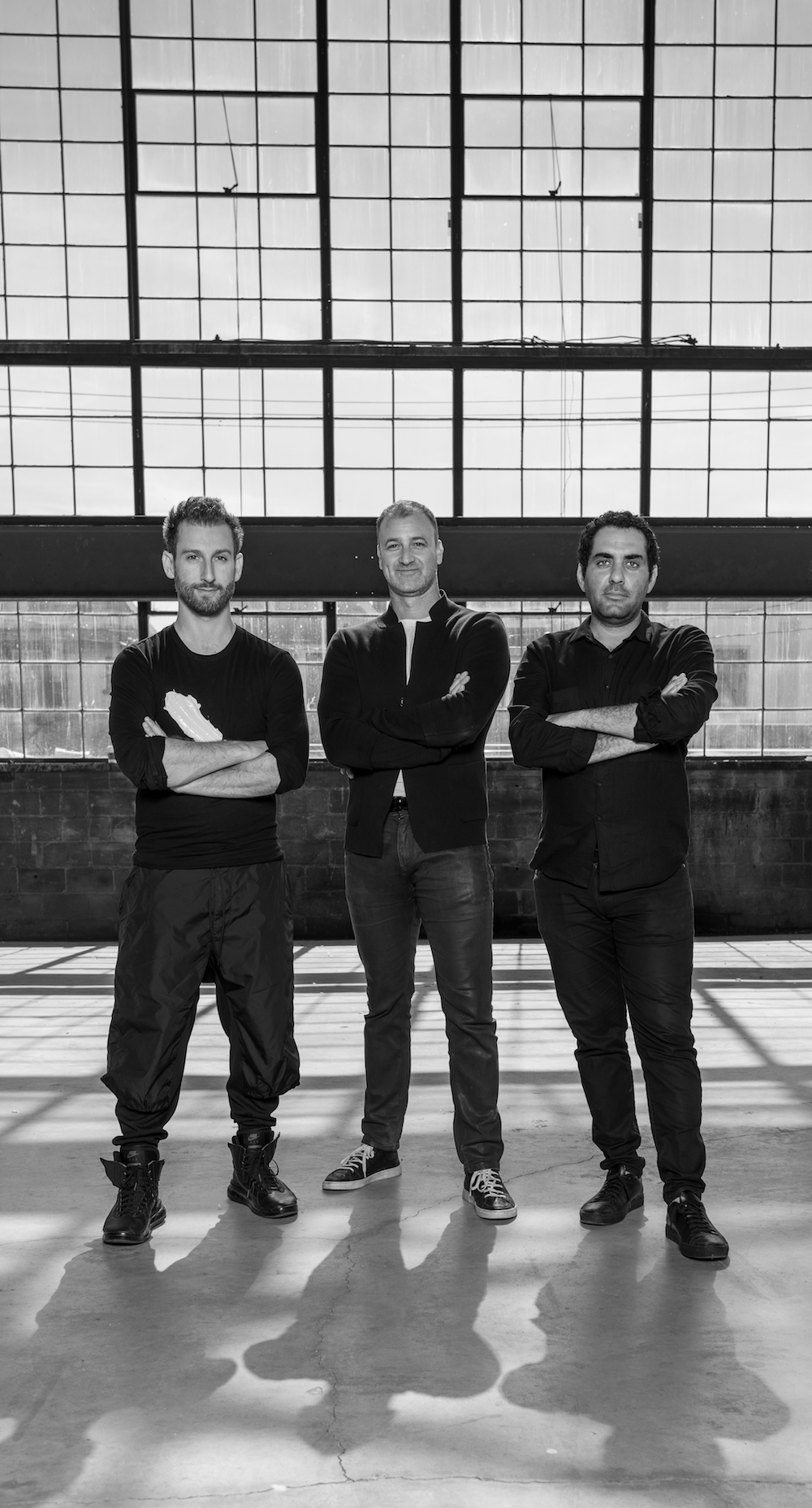
Courtesy of PARTISANS.
WHITEWALL: Alex, can you tell us how PARTISANS evolved after it was founded by you and Baktash to include Friedman later? How does your diversity as a group today—as a Canadian, an Iranian, and a South African—impact the way you collaboratively approach projects?
ALEX JOSEPHSON: Pooya and I met at the masters in architecture program at the University of Waterloo and began collaborating in 2008 while in school still. I was working on a project for a temporary mosque and masterplan for Mecca, he was working in Los Angeles, and dirigibles, it was a match made in heaven! We both liked helping each other, our interests intersected our backgrounds. Pooya likes to joke that he converted me, maybe we converted each other.
We both had similar approaches to innovation in design, and wanted to build a studio on a free and expansive approach to architectural practice and thought. We founded PARTISANS in a regulatory grey area right out of school, it was a big risk, especially in a country as conservative as Canada where it’s uncommon for newly minted graduates to not start a business. Hence the name PARTISANS. We’re about the free approach to design and the belief that architecture can shape the world for the better. After a year in, Jonathan joined us bringing a depth of experience and helped us bridge the rules. I think that Jonathan having grown up in Apartheid South Africa played a big role in why PARTISANS was appealing to him; values matter, and values can have form.
JON FRIEDMAN: What’s great about this partnership is that we come to the table with a lot of common histories and common concerns, but also a diverse, international, and varied set of experiences. Alex grew up in Toronto but has spent a considerable amount of time working in Italy, and Pooya is originally from Tehran and came to Canada to pursue his career in architecture. My upbringing was during apartheid in South Africa but have spent over 20 years in Canada. We are a studio that embraces creativity and innovation, and this only comes out of discourse and critical thinking and our different backgrounds and skills complement each other. I think this approach has resulted in richer projects and offers greater value for our clients.
POOYA BAKTASH: I came from Iran in 2007 to pursue my masters of architecture, without any long plan staying in Canada. I had several years of experience in construction and had worked in a successful young firm in Iran , but I was hungry for more and decided to come to Canada. Upon my arrival I was shocked how the architecture was so conservative in comparison to Iran and how apologetically Toronto saw itself as inferior to its neighbor cities like New York City or Chicago. I met Alex who just came back from Rome in Waterloo. The fact that we both lived around the world made us ambitious and critical of what we were seeing around us. This became the foundation of our friendship as we collaborated on our theses.
The idea of PARTISANS (a critical thinking studio) started organically from those long nights in school and grew to this day. We continue to keep the idea alive, even as the projects get bigger and more complex and value the risk taking, innovation, and most importantly, partnership. So, it was critical for our growth that Jon joined our team to strengthen our design and construction capabilities. Jon brought a depth to our process and was helpful to shifting our studio from being a boutique firm.
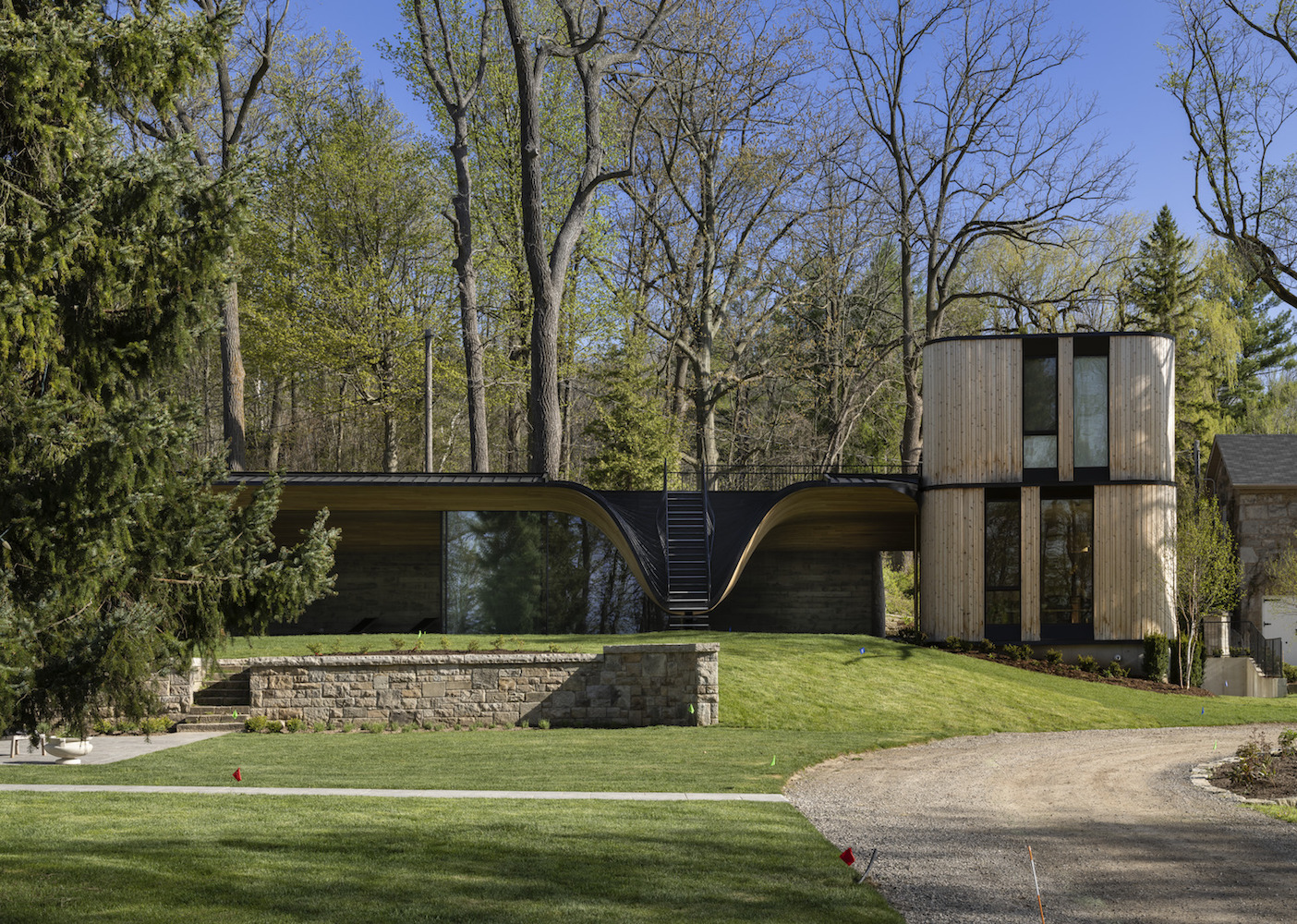
Fold House, courtesy of PARTISANS.
WW: How did your individual backgrounds lead to architecture, and founding PARTISANS?
AJ: I grew up in downtown Toronto in the 1980s and ‘90s, back then it was a different place and a bit of a bubble. So, between 2001 and 2010 I did everything I could to live abroad and became a bit of an academic nomad, jumping from Los Angeles twice, New York twice, Paris, London, and finally Rome for four years, before coming back to Toronto to defend my thesis and starting PARTISANS in the wake of the financial crisis.
JF: I’ve always wanted to be an architect. Growing up in South Africa during the Apartheid era, I was hyper aware of my surroundings, the way spaces were structured, how they orchestrated social and political interactions, how they made people feel. At the same time, it was a very rich, almost surreal environment and as a kid I dreamed of creating incredible, limitless architecture: homes, hotel resorts, towers. I moved to Toronto during my teen years and the largely grey, monotonous contrast at that time was striking. Fast forward a number of years, and having traveled and lived in various places around the world, I worked in several boutique and large international architecture firms. I did this until I was licensed, then my entrepreneurial spirit overtook me and I decided to strike out on my own. I knew what Alex and Pooya were up to (having all graduated from the University of Waterloo School of Architecture) and I could tell from a couple of early projects that they were charting a new course for young architects in Canada and that excited me.
PB: I always wanted to be a movie director, so architecture was the closest one . I studied architecture at Tehran University and was lucky to be working in a young and avant-garde studio and see the growth and manage complex projects closely. Despite winning awards and commissions in the firm, I was hungry and was looking for something bigger and international experience. I came alone to Canada in 2007 to study at the University of Waterloo. There I met Alex and the PARTISANS story started from there. We both embraced the risk taking which was integral to our business and allowed us to grow exponentially.
We started the firm after graduating from school so the studio was born out of a belief in breaking the norms and standards that is where the name PARTISANS comes from. From the beginning of practice, experimental design has been our main differentiator and we leverage technology to deliver complex projects.
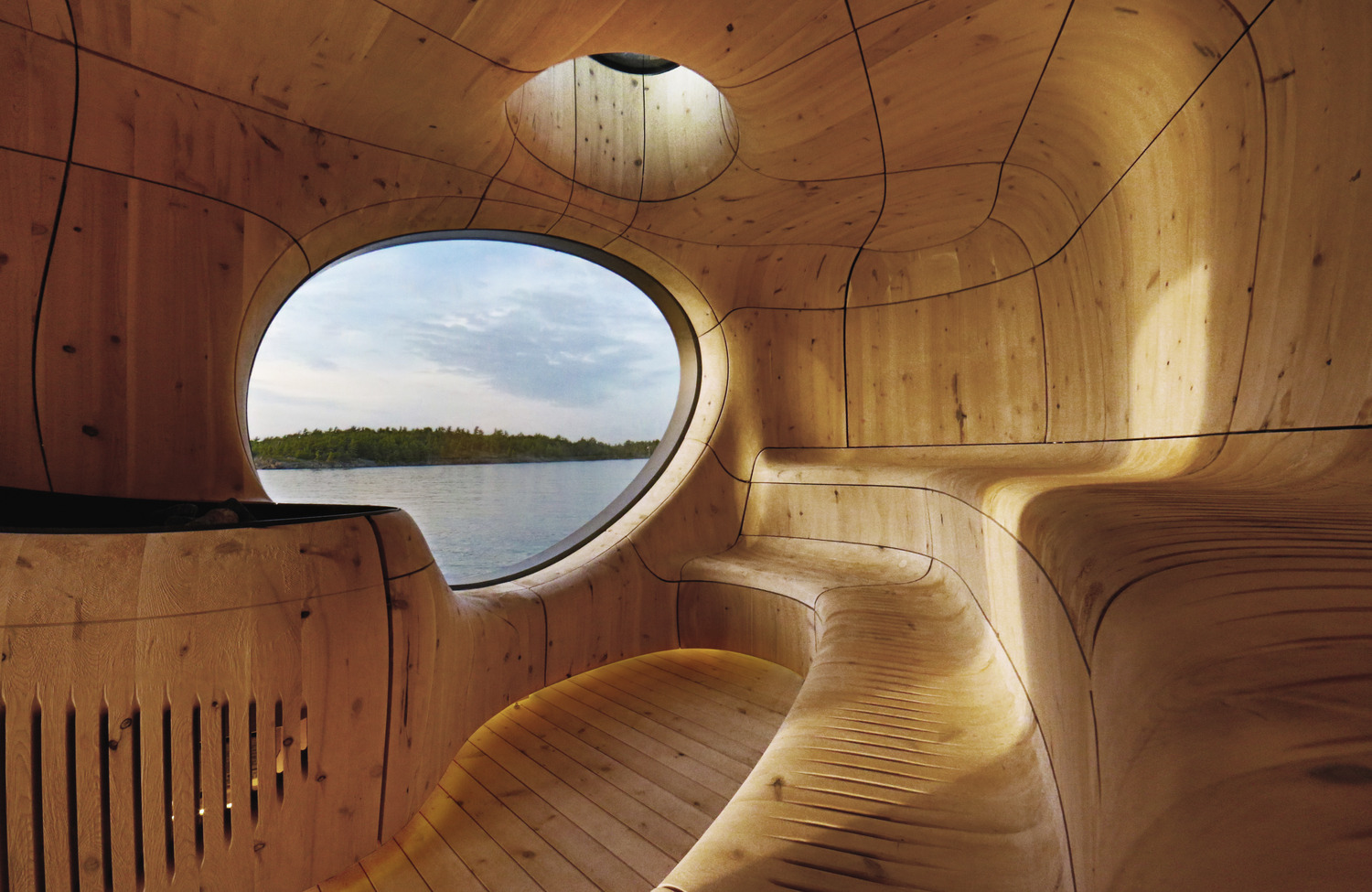
Grotto Sauna, courtesy of PARTISANS.
WW: Your design last year for The Orbit revealed a cutting-edge plan for downtown Toronto. What will this include?
AJ: The Orbit is our vision of a cutting-edge concentric masterplan for the Canadian town of Innisfil, designed in response to the arrival of high-speed mass transit that will connect the town to downtown Toronto. In a post COVID-19 world, migration from hyper dense city cores make sustainable new communities like The Orbit attractive. In many ways The Orbit re-imagines rural communities and continues the rich tradition of the garden city design within the field of architecture.
The first phase of the Orbit will take place over the next 3 to 5 years, which will include developing the GO Train Station and the immediate surrounding buildings including residential towers, retail and hospitality spaces, a bus and car route, and green space throughout with public art installations. PARTISANS designed the GO Train station to integrate landscaping that converts the central infrastructure of the Orbit into a park-like space, a nod to the rural surroundings of the community. The station’s roof itself becomes a landscape, functioning both as a central hub of transit and a dynamic center of interaction and recreation for the surrounding community.
The Orbit is PARTISANS’s way of contributing to the history of ideal city design in architecture.
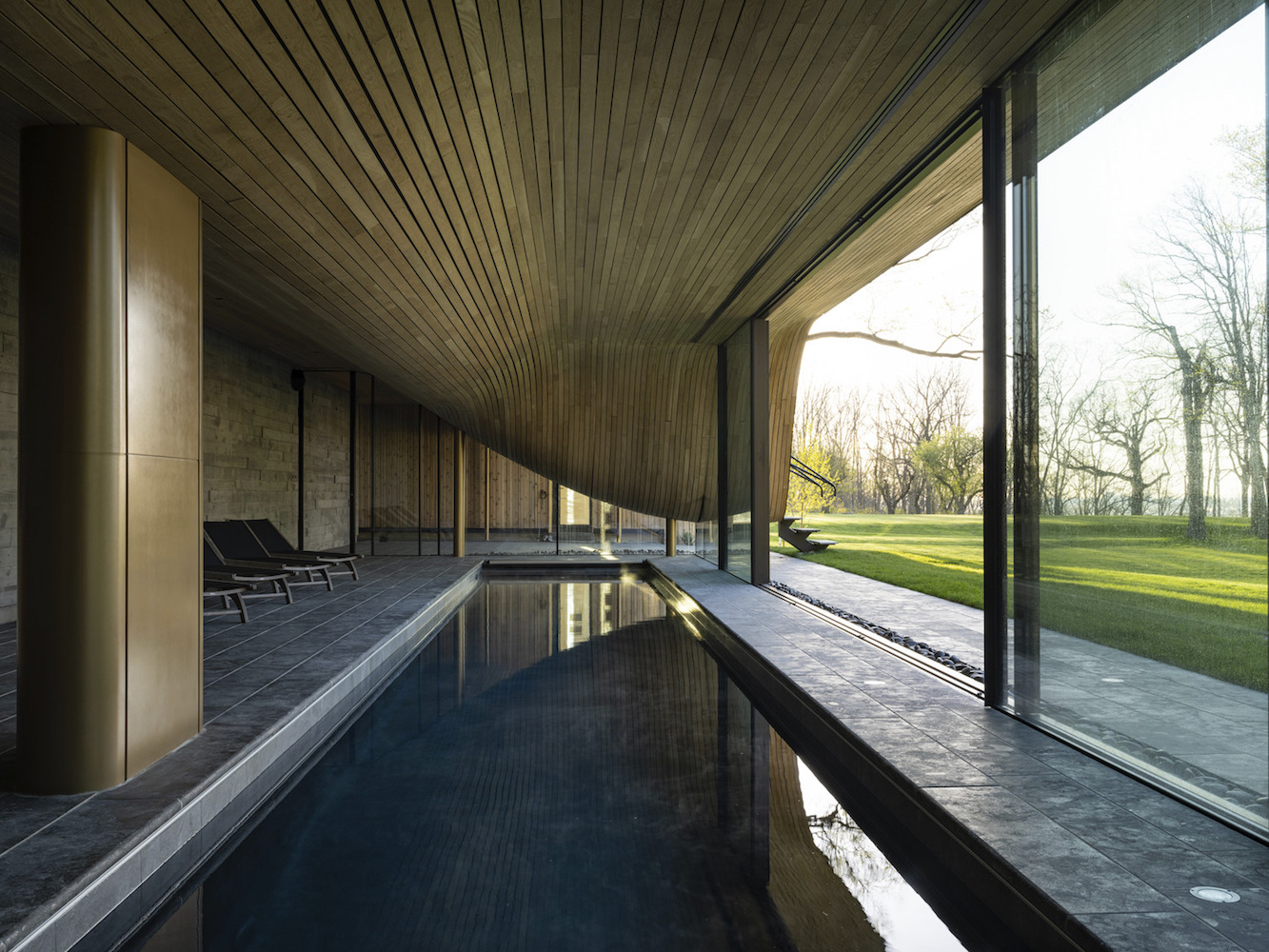
Fold House, courtesy of PARTISANS.
WW: Can you tell us about your recent design plan for the Fold House?
AJ: The Fold House was an incredible project to work on and our clients were great partners in the journey. They were looking to create an exceptional piece of architecture that would respond and embrace the surrounding landscape. The home was actually a replacement for a guest cottage that burned down on the property in 2017 due to an electrical fire. The rest of the property includes several smaller buildings including a coach house, a period mansion, and a barn—so it’s a beautiful juxtaposition having this modern home on the property.
The Fold House got its name as the folding theme was carried throughout the design. All corners were softened and curved and then there’s the striking feature in the middle of the house—a massive fold that cradles a staircase. This process required complex methods to compress the wood into the plywood ribs which served both as a guide and support structure to fasten the planks.
WW: How has COVID-19 impacted your practice, and/or the way you are approaching projects right now and plan to in the future?
JF: Covid has been an unprecedented event, impacting lives, livelihoods, relationships and health. I’m sure we don’t even know the full impact of it yet. Since we are a studio based on innovation, we saw Covid as an opportunity to evolve and be better. In early March 2020, before the stay-home orders took effect, we recognized that our industry was fundamentally changing, and we were going to have to be nimble and re-invent the way we worked together. Since we regard our studio a “project” we saw this as an opportunity to turn a potential negative into a positive by moving our entire workflow to the cloud. Pooya was instrumental in leading this. Architecture is a fundamentally collaborative and iterative process we invested heavily in new collaborative platforms that allow us to communicate, create and share in real time. We are more efficient and collaborative as a result.
One main challenge of Covid is that we are a very social studio and place great importance on our physical space, as a place to work, socialize and spend time with clients. In Fall 2019 we moved into a 11,000-square-foot open studio warehouse, at the heart of which is the gallery space, lounge and kitchen, which is not only the social hub of the studio—for shared meals, crits, and impromptu meetings—but also a venue for us to host design events and social gatherings. So, we certainly miss this social aspect of being together in our studio with our team and our clients, but we know now to appreciate it even more when we get back there.
In addition, putting in place the infrastructure to work remotely has liberated us in many ways – we have formed partnerships with experts around the world, enabling us to extend beyond our immediate geography. We are actively looking to take on more projects across the globe and now through technology and international partnerships, we are able to seamlessly and effortlessly bring our studio to anyone, anywhere in the world.
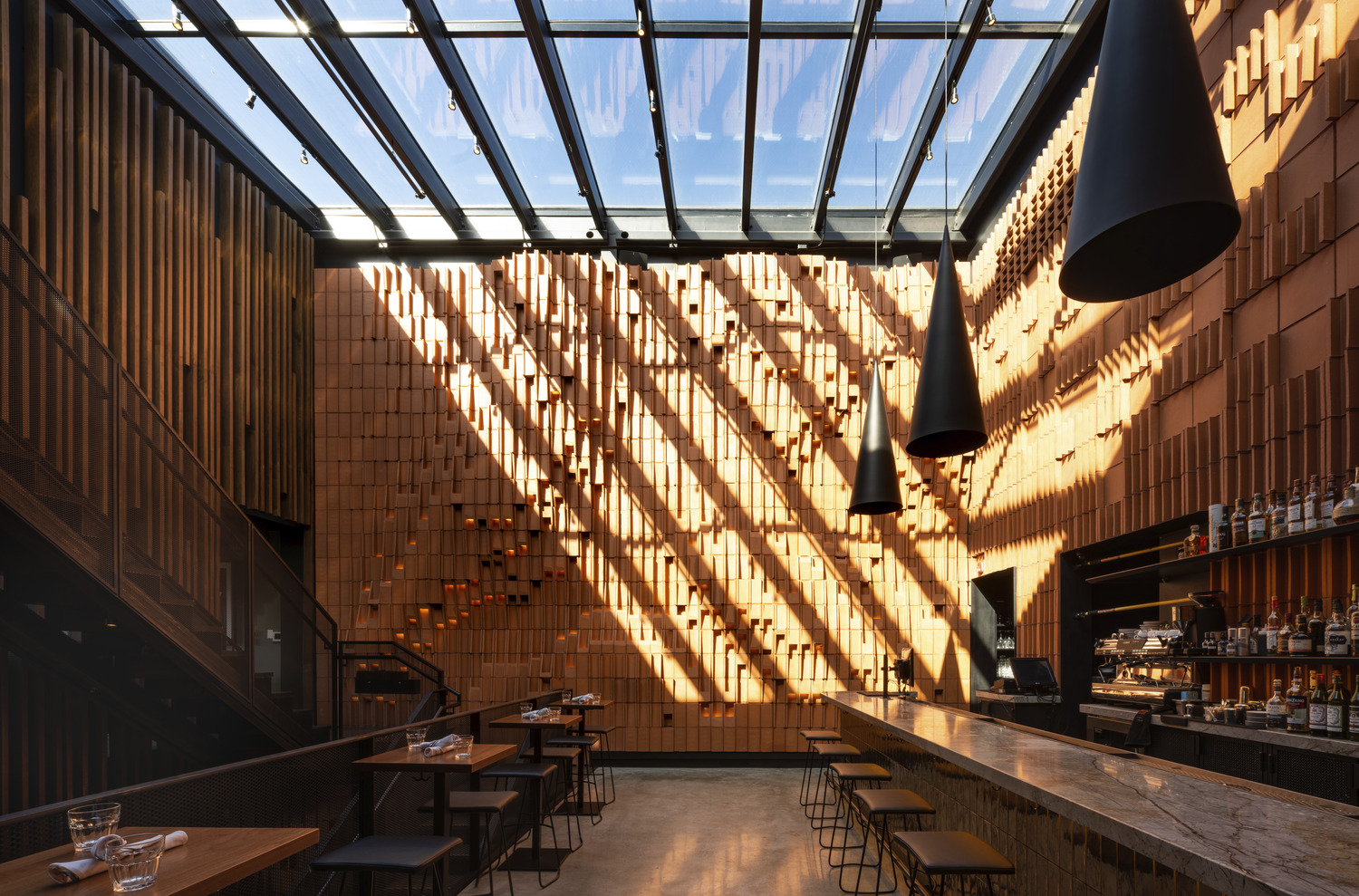
Gusto 501, photo by Jonathan Friedman, courtesy of PARTISANS.
WW: You mentioned that “beauty emerges when design misbehaves.” Can you give us a Partisans example of this?
AJ: It means that we’re fighting for our freedom to break with conventions and create great design and architecture. We have to go beyond the brief. When we were just out of architecture school and starting a studio ourselves, just establishing our own studio and own conventions felt like the cause we were fighting for. As the studio and our practice has evolved, this concept has remained central to our work as a commitment to challenging norms and pushing boundaries to create something new and great.
WW: You also mentioned you aspire to “realize better cities by innovating on the frontlines of ideas, cultures, forms, materials, and typologies.” What type of innovation on these fronts are you working on right now?
PB: We are currently working on a new model for affordable housing that is based on a circular economy and looking at the effect of affordable housing in the life cycle of the neighborhood and the city. Traditionally, architects were concerned with the construction of housing and saw buildings as static objects. We see the housing as prototypes and focusing on ways the building could be modified or taken apart in future.
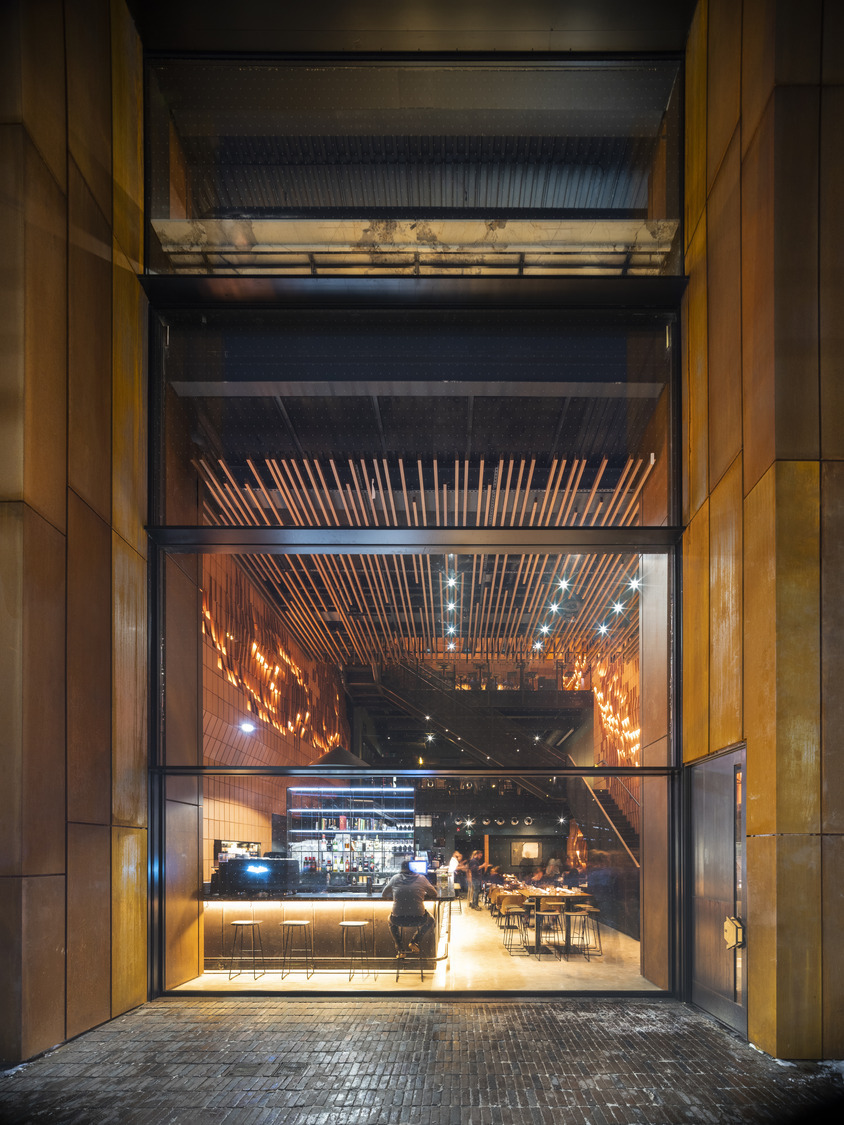
Gusto 501, photo by Nic Lehoux, courtesy of PARTISANS.
WW: With more people spending more time at home to both work and live, among many other activities, does this impact the way you are viewing design changing in the future?
JF: Spending more time at home and indoors has made people hyper aware of their surroundings. We as architects are trained to think this way, but I believe there is now a greater understanding and appreciation for well-designed spaces and places that inspire and uplift us. At PARTISANS, we are constantly asking ourselves, “How can architecture do more for us, and be better for us and our environment?”
Our recently completed Fold House (mentioned earlier) atop the idyllic Niagara escarpment, is centered around family wellness, incorporating principles of Feng Shui into the design, while our Bent House, overlooking a water-filled quarry in Caledon (starting construction), creates a truly healthy retreat removing electromagnetic fields and air-borne pollutants. Both projects feature ample natural light and ventilation, natural materials, flexible open spaces with incredible views and an emphasis on family. So, we see future clients wanting to not only tell their personal story through architecture but to create sanctuaries of health and wellness.
The other evolving change that we have long recognized is the need for the spaces we occupy to be more adaptable and do more for us; we see this at home, where family life, work life, exercising and socializing online of all things, are intersecting new and complex ways. Outdoors too, people are using space differently – shopping, dining and gathering. For us, this is a continuation of our belief that architecture should allow for a myriad of uses and that complexity and contradiction are challenges to be embraced, and in fact gives rise to new forms and opportunities. Our buildings have to be more flexible and adaptable to change than ever before.
Gusto 50—a 10,00-square-foot from the ground up restaurant—goes beyond expectations to intersect food, culture, art, and performance through architecture. Spaces are highly flexible and adaptable, such that during Covid restrictions dining areas were easily modifiable enabling the restaurant to pivot and evolve. We designed one of the largest operable glass facades in the world, to completely open the restaurant to the neighbourhood, creating a hybrid indoor/outdoor space and I believe we will see more adaptable buildings and facades in the future.
WW: What is PARTISANS working on next?
PB: We see our studio as our project. We aren’t interested in growing for the sake of growing or doing big projects for the sake of the financial windfalls. We are genuinely interested in the articulation of our methods and aesthetics for internal as well as external purposes. We want to make an impact on our profession as well as the world we work in. Beyond that we want to create unparalleled prosperity for our studio and its members.
Project-wise, we are working on a few true-mixed-use towers ranging from 30 to 72 storeys in height and we are very excited about them, one will probably already be public information by the time this article is posted. We are working on a festival plaza for Windsor, Ontario a city three hours west of Toronto and neighboring Detroit. We are working on a couple of great homes that are ambitious as well. Finally, we are working on a showstopper high street retail project that is going to make a big splash here in Toronto for a world-renowned brand.
Beyond that we have some incredible research and partnerships we are working on in the sphere of affordable housing. Our research work in this field has also previously won significant government grants for the ambitions and breadth of the possible outcomes we have developed. This project is really exciting to us because it is true to our mandate and brand PARTISANS, fighting for everyone not just the privileged.
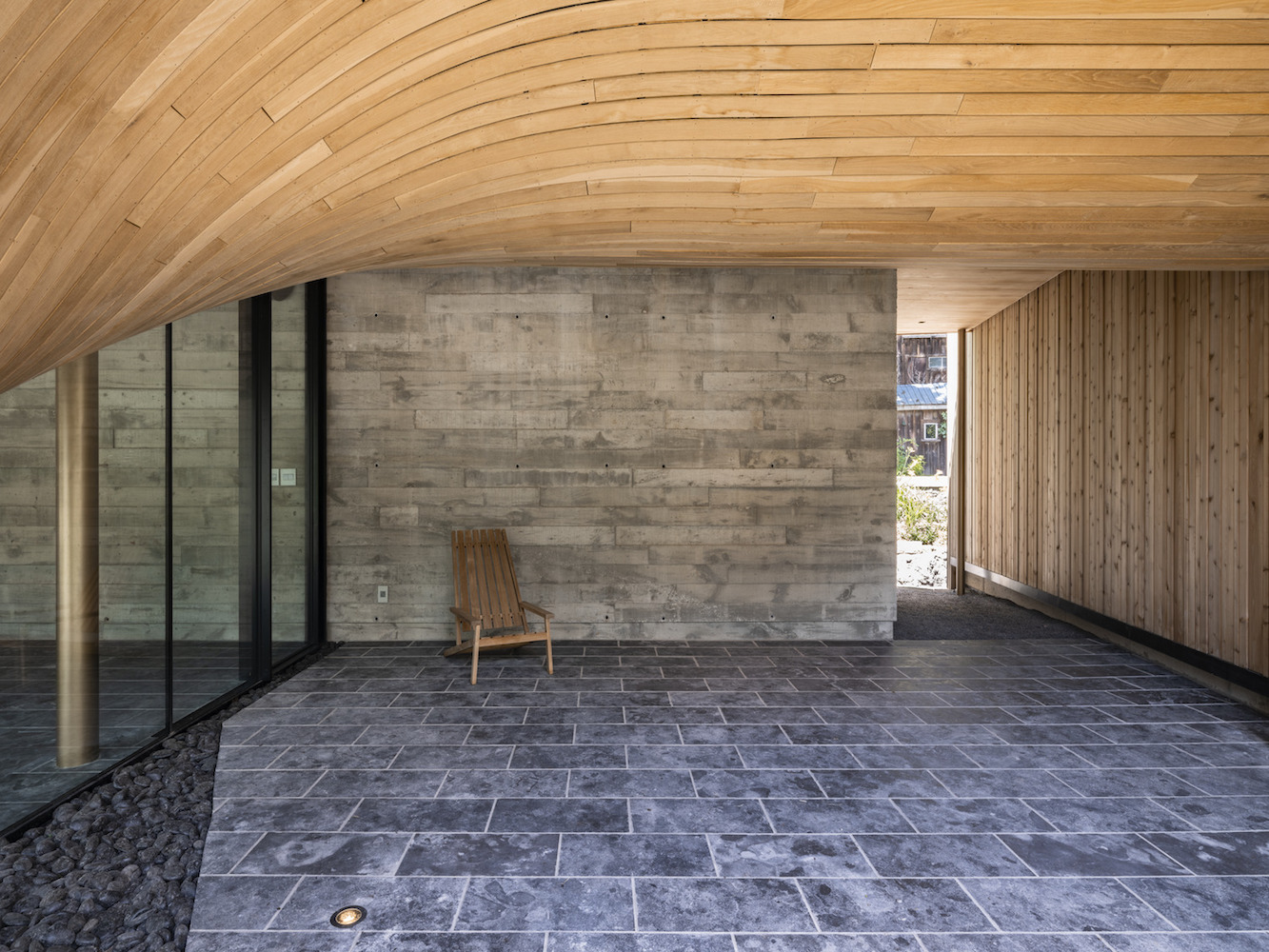
Fold House, courtesy of PARTISANS.
WW: Where do you feel the future of design is?
JF: Our daily lives are more complex and connected than ever before through the networks and systems we engage with. We need new ways to solve these challenges. Design helps organize our world to provide the best possible outcome. In that sense, we are optimists, believing that we can create a better future through design. We are currently seeing a convergence of technologies, where digital and physical processes are coming together in the form of incredible new ways of building, such as 3-D printing at large scale or biologically grown building materials.
This allows for not only radical new forms of architecture, but a more responsive architecture. In our work for Sidewalk Labs, we developed a prototype kit-of-parts structure that could be deployed in cities to increase the comfort levels of people being outdoors in the shoulder seasons (pre-Covid, which is now proving to be a sought after staple of urban life). Using a cushion of lightweight, transparent ETFE, the skin of the structure could be controlled intuitively via sensors to react to changing environmental condition, such as inflating a dot pattern to block more light during peak sun hours or automatically modulating air flow if the wind changed direction. Like our work for Sidewalk Labs, architecture will become more responsive and adaptive.
In addition, we are starting to see the broader idea of a circular economy being applied more widely, to include social, economic and environmental wellbeing and the design of our cities is at the centre of this. Rather than designing for permanence as we in the West have typically done, the circular economy champions non-permanence—adaption, re-use, re-constitution. Buildings are meant to change and evolve rather than being fixed and static. This will change our perception of what good value is and I think we will invest more in quality, recognizing up-front investment in design, means things that well-made, easily modifiable and repairable and this shift away from a building meant to last a lifetime to one that can be taken apart at some point or repurposed into something else, will alter the way we think about and construct our buildings and cities.




